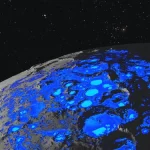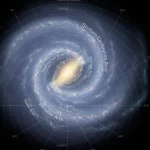Key Takeaways:
- The asteroid Kamo’oalewa, discovered in 2016, may be a chunk ejected from Earth’s moon due to a massive impact, according to a recent study.
- The Ferris-wheel-size rock orbits within 9 million miles of Earth every April, displaying unusual orbital properties that caught astronomers’ attention.
- Analysis of Kamo’oalewa’s composition in 2021 revealed similarities to moon rock, prompting researchers to explore the possibility of a lunar origin.
- The study, published in Communications Earth & Environment, suggests that the moon could be a significant source of similar near-Earth asteroids.
- Researchers aim to further investigate the conditions leading to the asteroid’s current trajectory, providing insights into the behavior of hazardous near-Earth asteroids.
A novel simulation has uncovered intriguing evidence suggesting that the asteroid Kamo’oalewa might be a remnant ejected from Earth’s moon due to a significant impact.
Astronomers have presented additional proof supporting the hypothesis that a near-Earth asteroid, Kamo’oalewa, is, in fact, a fragment expelled from the moon.
Known as “the oscillating fragment” in Hawaiian, Kamo’oalewa is a rock mass approximately the size of a Ferris wheel, maintaining an orbit within 9 million miles (14.4 million kilometers) of Earth annually, specifically in April.
Ever since its discovery in 2016, scientists have been grappling with the mysterious origins of this celestial body. The revelation in 2021 that Kamo’oalewa’s composition closely resembles that of the moon added to the intrigue.
In a recent study published on October 23 in Communications Earth & Environment, lead author Renu Malhotra, a planetary scientist from the University of Arizona, suggests a plausible scenario in which an ancient asteroid impact could have propelled this space rock into its current orbit. Moreover, the study hints at the possibility of other moon fragments dispersed throughout the solar system.
Malhotra stated, “We are now establishing that the moon is a more likely source of Kamo’oalewa.”
The unusual orbital characteristics of Kamo’oalewa prompted astronomers to delve deeper into their investigation. Firstly, being a “quasi-satellite” of Earth, it orbits so closely that it seems to circle our planet, although its actual orbital partner is the sun. Secondly, the asteroid is anticipated to remain in close proximity to Earth for millions of years, unlike many near-Earth objects that have shorter lifespans.
These peculiarities led researchers to analyze the asteroid’s spectra in 2021. The emitted and absorbed light from Kamo’oalewa indicated a composition resembling moon rock.
Malhotra explained, “We looked at Kamo’oalewa’s spectrum only because it was in an unusual orbit. If it had been a typical near-Earth asteroid, no one would have thought to find its spectrum, and we wouldn’t have known Kamo’oalewa could be a lunar fragment.”

Through simulations of asteroid impacts on the moon and the ensuing gravitational forces on ejected fragments, researchers uncovered the slim possibility that some of these rocks could end up in near-Earth orbits. Prior to these calculations, astronomers primarily expected lunar material to either return to the moon or descend to Earth, rather than adopting distant orbits around the sun.
The researchers believe their findings could enhance our understanding of potentially hazardous near-Earth asteroids. Their subsequent steps involve determining the conditions that led to the asteroid’s orbit and pinpointing the precise timing of the impactful event.


